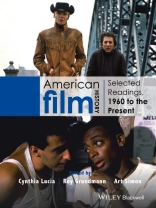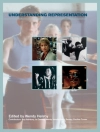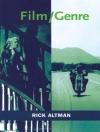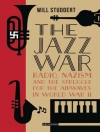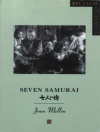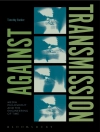From the American underground film to the blockbuster superhero, this authoritative collection of introductory and specialized readings explores the core issues and developments in American cinematic history during the second half of the twentieth-century through the present day.
* Considers essential subjects that have shaped the American film industry–from the impact of television and CGI to the rise of independent and underground film; from the impact of the civil rights, feminist and LGBT movements to that of 9/11.
* Features a student-friendly structure dividing coverage into the periods 1960-1975, 1976-1990, and 1991 to the present day, each of which opens with an historical overview
* Brings together a rich and varied selection of contributions by established film scholars, combining broad historical, social, and political contexts with detailed analysis of individual films, including Midnight Cowboy, Nashville, Cat Ballou, Chicago, Back to the Future, Killer of Sheep, Daughters of the Dust, Nothing But a Man, Ali, Easy Rider, The Conversation, The Texas Chain Saw Massacre, Longtime Companion, The Matrix, The War Tapes, the Batman films, and selected avant-garde and documentary films, among many others.
* Additional online resources, such as sample syllabi, which include suggested readings and filmographies, for both general and specialized courses, will be available online.
* May be used alongside American Film History: Selected Readings, Origins to 1960 to provide an authoritative study of American cinema from its earliest days through the new millennium
Innehållsförteckning
Volume II: 1960 to the Present
Acknowledgments xii
Preface xiii
Part I 1960-1975
1 Setting the Stage: American Film History, 1960-1975 3
Notes 21
References 21
2 Adults Only: Low-Budget Exploitation 23
Eric Schaefer
Note 35
References 35
3 Black Representation in Independent Cinema: From Civil Rights to Black Power 37
Alex Lykidis
Notes 52
References 54
4 Cinema Direct and Indirect: American Documentary, 1960-1975 56
Charles Warren
Notes 70
References 70
5 Comedy and the Dismantling of the Hollywood Western 72
Teresa Podlesney
Note 86
References 86
6 The New Hollywood 87
Derek Nystrom
Notes 103
References 103
7 ’One Big Lousy X’: The Cinema of Urban Crisis 105
Art Simon
References 118
8 Nashville: Putting on the Show: Or, Paradoxes of the ’Instant’ and the ’Moment’ 120
Thomas Elsaesser
Notes 131
References 132
9 Cinema and the Age of Television, 1946-1975 134
Michele Hilmes
Notes 146
References 146
Part II 1976-1990
10 Setting the Stage: American Film History, 1976-1990 151
Notes 173
References 173
11 Seismic Shifts in the American Film Industry 175
Thomas Schatz
Notes 188
References 188
12 Independent Film: 1980s to the Present 190
Geoff King
References 204
13 Reclaiming the Black Family: Charles Burnett, Julie Dash, and the ’L.A. Rebellion’ 205
Janet K. Cutler
Notes 218
References 221
14 Feminism, Cinema, and Film Criticism 223
Lucy Fischer
References 238
15 American Avant-Garde Cinema from 1970 to the Present 241
Scott Mac Donald
Note 258
References 258
16 A Reintroduction to the American Horror Film 259
Adam Lowenstein
Note 274
References 274
17 Back to the Future: Hollywood and Reagan’s America 275
Susan Jeffords
References 285
18 ’Stayin’ Alive’: The Post-Studio Hollywood Musical 286
Karen Backstein
Notes 301
References 302
Part III 1991 to the Present
19 Setting the Stage: American Film History, 1991 to the Present 307
Notes 329
References 329
20 The Queer 1990s: The Challenge and Failure of Radical Change 330
Michael Bronski
Notes 344
References 346
21 24/7: Cable Television, Hollywood, and the Narrative Feature Film 347
Barbara Klinger
Notes 360
References 360
22 Plasmatics and Prisons: The Morph and the Spectacular Emergence of CGI 362
Kristen Whissel
References 375
23 Mainstream Documentary since 1999 376
Patricia Aufderheide
References 391
24 Truthiness Is Stranger than Fictition: The ’New Biopic’ 393
Michael Sicinski
Notes 407
25 ’Asia’ as Global Hollywood Commodity 408
Kenneth Chan
Notes 421
References 422
26 The Blockbuster Superhero 423
Bart Beaty
Notes 437
References 437
27 Limited Engagement: The Iraq War on Film 438
Susan L. Carruthers
Notes 453
References 453
28 The Biggest Independent Pictures Ever Made: Industrial Reflexivity Today 454
J. D. Connor
Notes 468
References 469
29 Writing American Film History 471
Robert Sklar
References 481
Index 483
Om författaren
Together, Cindy Lucia, Roy Grundmann, and Art Simon are the editors of the four volume reference work, The Wiley-Blackwell History of American Film (2012), of this volume and its companion, American Film History: Selected Readings, Origins to 1960 ( both 2016), all published by Wiley-Blackwell.
Cynthia Lucia is Professor of English and Director of Film and Media Studies at Rider University. She is author of Framing Female Lawyers: Women on Trial in Film (2005) and writes for Cineaste film magazine, where she has served on the editorial board for more than two decades. Her most recent research includes essays that appear in A Companion to Woody Allen (Wiley, 2013), Modern British Drama on Screen (2014), and Law, Culture and Visual Studies (2014).
Roy Grundmann is Associate Professor of Film Studies at Boston University. He is the author of Andy Warhol’s Blow Job (2003) and the editor of A Companion to Michael Haneke (Wiley 2010). He is Contributing Editor of Cineaste and has published essays in a range of prestigious anthologies and journals, including GLQ, Cineaste, Continuum, The Velvet Light Trap, and Millennium Film Journal. He has curated retrospectives on Michael Haneke, Andy Warhol, and Matthias Müller.
Art Simon is Professor of Film Studies at Montclair State University. He is the author of Dangerous Knowledge: The JFK Assassination in Art and Film (2nd edition, 2013). He has curated two film exhibitions for the Solomon Guggenheim Museum in New York City and his work has been published in the edited collection ’Un-American’ Hollywood: Politics and Film in the Blacklist Era (2007) and in the journal American Jewish History.
